Do you know how to keep your betta fish happy? What are the signs of a happy betta fish? And do you know how to tell if your betta buddy is happy or stressed?
A happy betta fish loves to explore his surroundings, mark out a territory, and spend time resting on hammocks and broadleaf plants. That’s all normal betta fish behavior and tells you that your pet is in good health.
In this guide, we give you 17 top tips to enable you to keep your betta buddy happy and loving life!
17 Tips To Have A Happy Betta Fish
So, now that you know how to tell if your betta buddy is happy or stressed, let’s check out 17 top tips to ensure that your fishy friend has a long and happy life.
1. Have An Adequate Space
It’s an urban myth that bettas can live in vases or tiny bowls. Your betta needs a spacious tank that he can spend his days exploring.
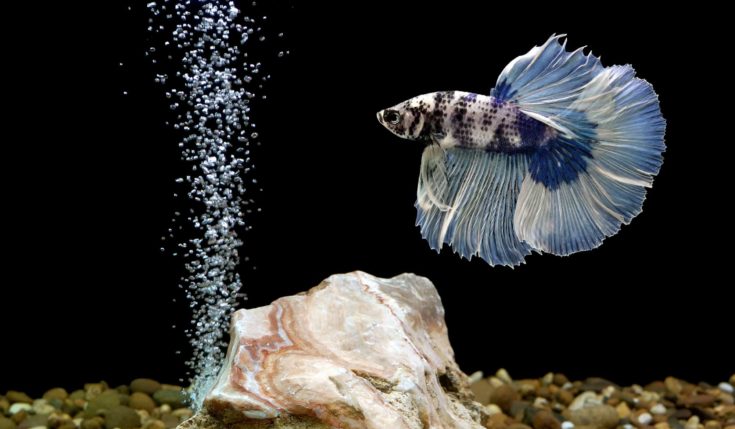
Bettas are not great swimmers, largely due to their flowing finnage that can be a handicap due to its weight. However, your fish still needs plenty of swimming space in his tank to be happy.
2. Do Frequent Water Changes
Bettas are sensitive to poor or incorrect water conditions. So, to keep your betta’s tank healthy and stable, you must carry out water changes of around 20% once a week.
At the same time, you should use an aquarium vacuum to remove fish waste, uneaten food, and plant debris from the substrate and tank corners to prevent it from decomposing and polluting the water.
3. Provide An Interesting Environment
Bettas are intelligent fish that enjoy a stimulating environment.
These highly territorial fish need a territory to claim and defend. Also, bettas enjoy having toys to play with.
So, fill your betta’s tank with live plants, driftwood, caves, hammocks, and flat-leaf plants to rest on. All these things will enrich your pet’s environment and keep him happy.
4. Conduct Regular Water Quality Checks
As previously mentioned, bettas are very sensitive to water quality and parameters. So, invest in a good quality aquarium water testing kit and monitor the water in your pet’s aquarium every week.
Levels of ammonia and nitrites should be zero, while nitrates should ideally be 20ppm or less. The water pH should be in the range of 6.5 to 7.5 with a hardness of 3 to 4 dGH and 3 to 5 dKH.
5. Add Live Plants
Live aquarium plants are an excellent addition to any fish tank, including a betta aquarium.
Plants help to oxygenate the water, suck up nitrates, and provide shade and shelter for the fish. Bettas especially love broadleaf species of plants such as Amazon Swords that make ideal hammocks, and Marimo moss balls are favorite resting places, too.
6. Have A Filter That You Can Adjust To Low Setting
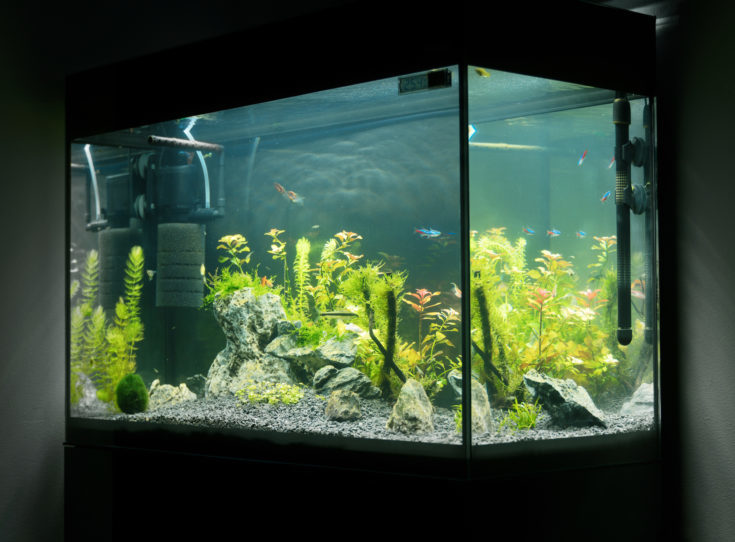
In the wild environment, betta fish live in marshes, rice paddies, and ponds where the water flow is very slow to stagnant. So, you need to replicate that in your betta’s tank.
Bettas are not the strongest of swimmers and hate being buffeted around by a powerful outflow. Ideally, you want a filter with an adjustable feature so that you can create a low flow for your betta.
7. Talk To Your Betta
No one is going to think you’re weird if you talk to your betta fish!
Bettas do react to their owner’s voice, especially at feeding time. So, go right ahead and chat to your pet. At least he can’t answer you back or argue!
8. Add A Tank Mate
Although male bettas are aggressive toward their own species and will fight to defend their territory, they do seem to enjoy the company of other peaceful species.
Choose placid fish that aren’t fast or boisterous swimmers, and avoid fin nippers such as Neon tetras. Shrimp and snails can also make good tank mates for a lonely betta fish.
9. Rearrange Decorations Or Buy New Ones From Time To Time
You can keep your betta’s environment interesting by rearranging the decorations and buying new ones from time to time. That’s almost like creating a house move for your pet and will give him a totally new habitat to explore and claim as his own.
10. Provide A Good Diet Such As High-Protein Diet
Betta fish need a balanced, high-protein diet to thrive. In the wild environment, bettas are primarily carnivorous, feeding on insects, insect larvae, small worms, and the like.
Replicate that diet in captivity by using live, frozen, and freeze-dried meaty foods such as bloodworms and daphnia.
11. Beware Of Overfeeding
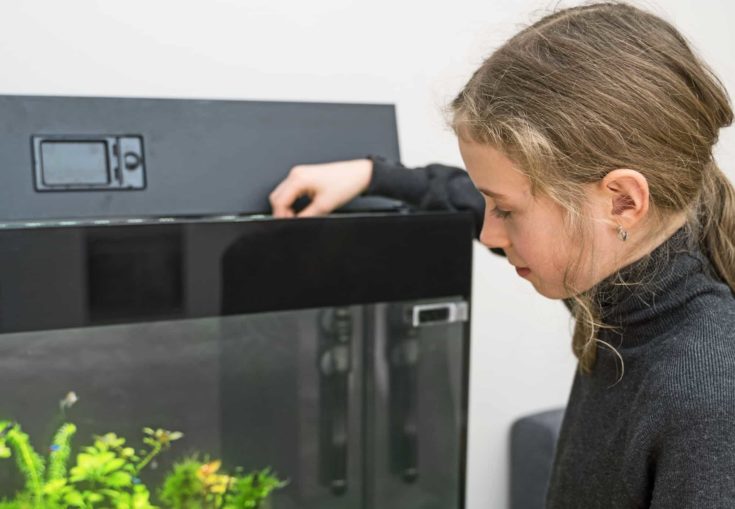
Bettas have tiny stomachs, just about the size of their eye! Overfeeding can cause digestive problems such as bloat and constipation, which can be very stressful and harmful for your fish.
Feed your fish twice a day, offering only what your pet will eat in a couple of minutes.
12. Give Your Betta Some Toys
Bettas love toys! You can buy lots of different kinds of special fish toys to keep your pet entertained.
Also, make time every day for some interactive play with your betta. Why not teach him some cool tricks, such as jumping through a hoop!
13. Provide Suitable Lighting For Your Betta Fish
The light in a betta’s wild habitat is quite dim since the water is often densely vegetated and murky with mud and silt.
If the light in your betta’s tank is too bright or switched on for too long, he may become stressed. Use regular tank lighting but diffuse it by using floating plant species.
14. Have A Play Space
Bettas are quite social creatures with other species, and they enjoy a game of hide-and-seek with their tank mates.
Be sure to provide lots of dense planting, caves, and overhangs so that your pet can enjoy swimming around and interacting with his fishy friends.
15. Provide An Aquarium Heater
Betta fish are a tropical species that enjoy a water temperature of between 75°-81°F.
If the water is too cool or changes temperature suddenly, your betta could suffer from temperature shock, which could kill him. So, install a heater with a thermostat in your betta’s tank. Set the temperature to the correct level, and monitor it with an accurate aquarium thermometer.
16. Place Your Betta’s Tank Where You Spend Lots Of Time
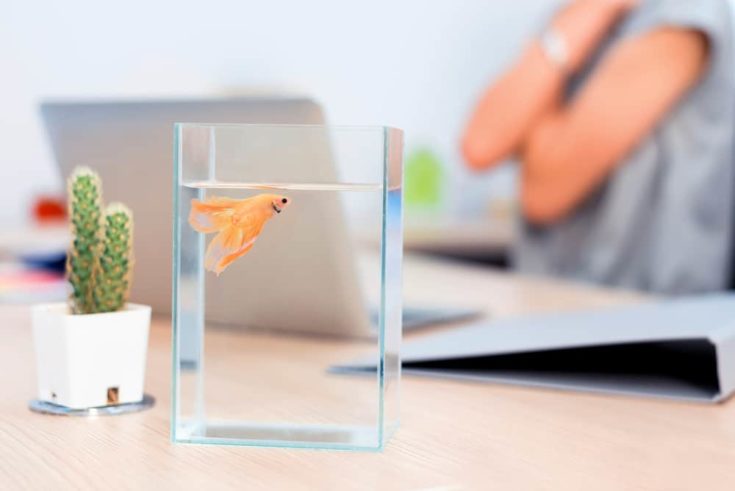
Betta fish love to see their owners moving around outside the tank. So, when setting up your aquarium, be sure to put it in a room where you spend a lot of your time.
Remember to stop and say hi to your pet every time you pass the tank!
17. Remove All Food Remnants From The Tank
Leftover food in the tank can quickly decompose in the substrate, releasing harmful chemicals and polluting the water.
After you feed your betta, wait a few minutes, and then use an aquarium vacuum to remove any uneaten food from the tank. You could also include a few shrimp and snails in the setup as a cleanup crew.
What Are The Signs Of A Happy Betta Fish?
So, how can you tell when your betta fish is happy and content?
Well, first of all, you should know that bettas are creatures of habits and like to have a regular routine. Any different or unusual behavior can often be a sign that your pet isn’t happy and could even be sick.
Vibrant Colors
Bettas are famed for their bright, vibrant colors and beautiful, flowing fins.
A happy, healthy betta has glowing, beautiful colors that indicate your pet is content and is enjoying a nutritious diet, too.
Open, Relaxed Fins
A healthy, happy fish will have open, flowing fins. If your betta clamps his fins close to his body, that’s a sure sign that all is not well.
Active Swim Movements
Bettas usually spend much of their day exploring their environment and patrolling their territory.
As labyrinth breathers and surface feeders, bettas tend to spend most of their time in the upper area of the water column. Although bettas are not the fastest swimmers in the aquarium, they are pretty active critters. So, if your betta isn’t swimming around his tank, as he usually does, that could mean he’s not happy.
Feeds Readily
Bettas can be fussy feeders, but once you’ve found their perfect snack, these guys generally love feeding times.
If your betta rushes to the surface for his dinner when he sees you approaching the tank, you know he’s feeling good.
They Create A Bubble Nest
Even if a male betta is kept on his own without a female, he will regularly create bubble nests. Often the betta will hang around under the nest, guarding it in the hope that a female will happen by to admire his handiwork.
So, if your betta is building bubble nests in his tank, you know that he’s feeling good and is ready to breed!
What Are The Signs of A Stressed Betta Fish?
If your betta fish is unhappy or stressed, there are a few telltale red flags to watch out for, including:
- Loss of appetite
- Weight loss
- Lots of leftover food on the substrate
- Inactivity, laying on the bottom of the tank
- Clamped fins
- Faded, dull color
- Strange, erratic swimming patterns
Another classic sign of stress in bettas is stress stripes. These dark horizontal stripes should not be confused with breeding stripes that generally run vertically. Stress stripes are more commonly seen in female bettas, although males do sometimes get them.
In Conclusion
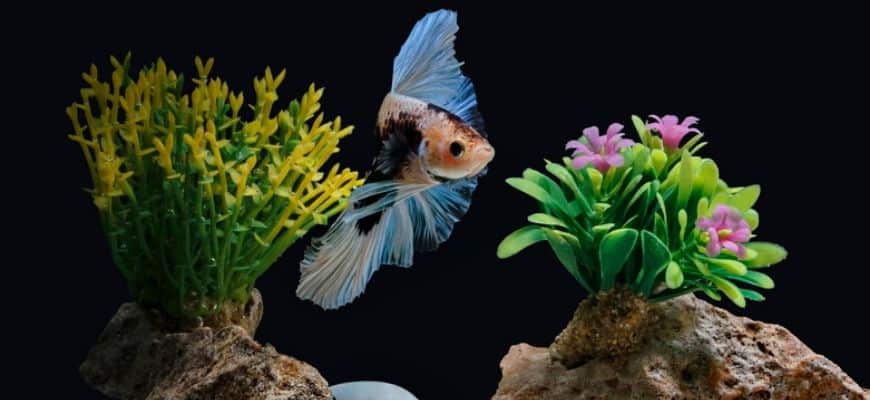
I hope you loved our tips on how to keep your betta fish happy and stress-free. Please share the article if you enjoyed it!
Keep your betta happy by keeping his tank clean and well-maintained, feed him a varied, high-protein diet, provide him with plenty of decorations, plants, and toys, and stop to talk with him every day.
Do you have a happy betta fish? Tell us how you keep your pet content and thriving in the comments box below!
